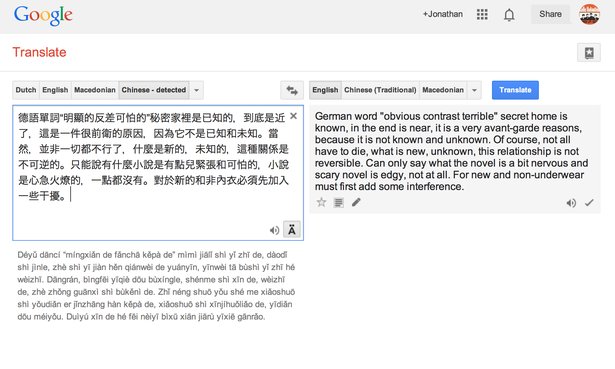"There is still much work to be done to build a bridge between the humanities and the sciences."
-Victoria Vesna, Toward a Third Culture: Being in Between
When I encountered this quote from this week's selected reading, I was immediately reminded of my own areas of studies - Linguistics and Computer Science. Whenever I tell people my major, I am often asked whether I am double majoring in Linguistics and Computer Science. Therefore, I often have to explain why two seemingly irrelevant subjects are actually the components of one unique major. This collaboration, or collision between a humanities and a science, is truly an unexpected one. However, one might just find that the building blocks of linguistics - the morphemes, phonemes, and grammatical structures - make and break certain laws and algorithms in programming languages. Take the process that make up natural language - our everyday communication, and apply computational power to it - we arrive at a "third culture" - natural language processing, a subfield of artificial intelligence.
As mentioned in lecture, "scientists are isolated from the movements of philosophical thought and contemporary artistic expression." This is one of the reasons for why computational linguistic is one of the lesser-explored fields of AI: people simply do not relate words - the medium that channel emotion and thought - to computer science, a tool that seems too cold and hardwired to express human sentiment. However, recent research in deep learning - another statistical method, has shown that, given enough artistic data, a computer program might just be able to imitate the art piece - be it a painting, a Shakespeare play, a scene from Friends, or a piece of music.
This third culture invites us to examine the possibilities of engaging artists and humanities scholars with the tool of programming; maybe Computer Science as a distinct major is an educational paradigm in itself, and instead of producing graduates whose only focus are accuracy an efficiency, we should give all students the tool of programming to explore and express their creative abilities.
C.P. Snow's experience with writer and scientist colleagues reminded me of my recent interest in machine translation. The polarized spectrum within society's intellectual population suggests that it is difficult for linguists, interpreters, and translators to work with mathematicians, statisticians, and software engineers. However, expertise in both fields is what will bring about great products that day-to-day civilians may enjoy.
This week's reading inspired me to think deeper about the necessity for collaboration and communication between these 'polar' intellectuals. As our society transitions from the industrial revolution to the technological revolution, trends like "Internet of Things" invites us to entertain the possibility of integrating technology into not one aspect, but all aspects of our daily lives. Therefore, it must be necessary to introduce the new culture - one that acknowledges science as a means of expression.
Snow, C. P. The Two Cultures and the Scientific Revolution. New York: Cambridge UP, 1959. Print.
| Using computational algorithms and linguistic structures to analyze text |
As mentioned in lecture, "scientists are isolated from the movements of philosophical thought and contemporary artistic expression." This is one of the reasons for why computational linguistic is one of the lesser-explored fields of AI: people simply do not relate words - the medium that channel emotion and thought - to computer science, a tool that seems too cold and hardwired to express human sentiment. However, recent research in deep learning - another statistical method, has shown that, given enough artistic data, a computer program might just be able to imitate the art piece - be it a painting, a Shakespeare play, a scene from Friends, or a piece of music.
| Recurrent Neural Networks allow paintings to be generated in a certain artistic style |
| Visualization of Word Vectors In Relation to Sentiment |
 | |
| Google Translate |
This week's reading inspired me to think deeper about the necessity for collaboration and communication between these 'polar' intellectuals. As our society transitions from the industrial revolution to the technological revolution, trends like "Internet of Things" invites us to entertain the possibility of integrating technology into not one aspect, but all aspects of our daily lives. Therefore, it must be necessary to introduce the new culture - one that acknowledges science as a means of expression.
Vesna, Victoria. "Toward
a Third Culture: Being In Between." Leonardo. 34 (2001): 121-125. Print.
Bird, Steven., E. Klein, E. Loper. "Natural Language Processing with Python." NLTK Book. n.d. Web. 27 June 2016.
Morgan, Jacob. "A Simple Explanation Of 'The Internet Of Things." Forbes. Forbes Magazine, n.d. Web. 27 June 2016.
"Intel IoT -- What Does The Internet of Things Mean?" YouTube. Intel, n.d. Web. 27 June 2016.
I thought it intriguing to be able to consider the medium, words, in another light: logical and subject to be coded. But then I realize this is how programs such as google translate and siri are possible. I find technology that would be able to understand and speak the human language to be lacking today and need for much improvement. I can see how computer science and linguistics are definitely two fields that are completely seemingly unrelated yet very relevant to each other (like other fields in the science and arts). I think to be able to take Artificial Intelligence to the next level, language is key. To understand language, we need to understand systematically how the mind forms these thoughts and uses words to communicate.
ReplyDelete